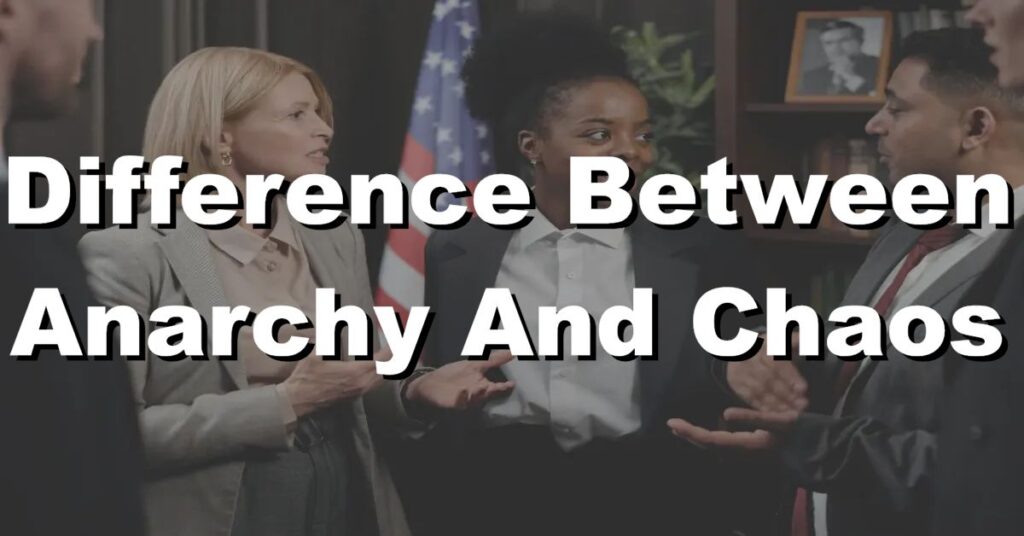Anarchy and chaos are two terms that are often used interchangeably. However, they have very different meanings. Anarchy is a political philosophy that advocates for the abolition of all forms of government and social hierarchies, while chaos is a state of complete disorder and confusion. In this blog post, we will explore the differences between anarchy and chaos, and how they relate to political philosophy.
Anarchy and Chaos: Defining the Terms and Understanding the Distinctions
Anarchy and chaos are two terms often used interchangeably, but they have distinct meanings and implications. Anarchy refers to a state of society without a centralized government or authority, where individuals are free to govern themselves. It is characterized by the absence of hierarchical power structures and coercive institutions.
On the other hand, chaos refers to a state of disorder, confusion, and unpredictability. It is associated with a lack of control or regulation, resulting in a breakdown of societal norms and stability.
While anarchy and chaos share elements of decentralized governance and lack of authority, they differ in their underlying principles and outcomes. Anarchy can be seen as a philosophical concept promoting individual freedom, voluntary cooperation, and non-coercive relationships.
It emphasizes self-governance and mutual respect among individuals. In contrast, chaos represents a state of disarray, where there is no coherent order or organization.
The History of Anarchy and Chaos: How the Terms Developed Over Time
The concepts of anarchy and chaos have a rich history that has evolved over time. The roots of anarchy can be traced back to ancient Greek philosophers such as Zeno of Citium and Epicurus, who advocated for self-governance and the absence of external authority.
In the 19th century, influential anarchist thinkers like Pierre-Joseph Proudhon and Mikhail Bakunin further developed the philosophy of anarchy as a response to oppressive state systems and the exploitation of individuals.
On the other hand, the term “chaos” has its origins in Greek mythology, where Chaos represented the formless state preceding the creation of the universe. In scientific and mathematical contexts, chaos theory emerged in the 20th century as a field studying complex and unpredictable systems.
The Philosophy of Anarchy and Chaos: Exploring the Theoretical Foundations
Anarchy as a philosophy emphasizes the autonomy and freedom of individuals. It argues for the rejection of hierarchical power structures and advocates for voluntary cooperation, mutual aid, and direct democracy. Anarchist theorists argue that centralized authority leads to oppression, inequality, and the suppression of individual freedoms.
They propose alternative models of governance, such as syndicalism, mutualism, or communalism, based on voluntary associations and collective decision-making.
Chaos theory, on the other hand, is a scientific and mathematical framework that studies the behavior of complex systems. It explores the notion that seemingly random and chaotic systems can exhibit underlying patterns and order. Chaos theory highlights the sensitivity of complex systems to initial conditions and small changes, leading to nonlinear and unpredictable behavior.
It has applications in various fields, including physics, biology, economics, and social sciences.
The Real-World Applications of Anarchy and Chaos: Examples and Case Studies
Real-world examples of anarchy can be found in various historical and contemporary contexts. For instance, the Spanish Revolution of the 1930s saw the establishment of self-governing anarchist communities in Catalonia and Aragon. These communities operated on principles of mutual aid, direct democracy, and collective decision-making.
In contrast, chaos theory has practical applications in fields such as weather forecasting, stock market analysis, and computer science. It helps researchers understand complex systems and predict their behavior within certain limits. For example, weather patterns and financial markets exhibit nonlinear and unpredictable dynamics that can be analyzed using chaos theory.
The Pros and Cons of Anarchy and Chaos
Advocates of anarchy argue that it promotes individual freedom, voluntary cooperation, and social equality. They believe that without a centralized authority, individuals can govern themselves in a more just and equitable manner. Anarchy encourages active citizen participation, fosters community solidarity, and allows for the exploration of diverse social arrangements.
However, critics of anarchy argue that without a centralized authority, social order may break down, leading to violence, instability, and the emergence of new power structures. They highlight the challenges of coordinating collective action, resolving conflicts, and addressing public goods issues in the absence of formal institutions.
Conclusion
In conclusion, while anarchy and chaos may seem similar, they are fundamentally different concepts. Anarchy refers to a political ideology based on the absence of government or authority, while chaos refers to a state of disorder or confusion.
Understanding the differences between these concepts can help individuals better understand political discourse and engage in productive discussions on important issues.

